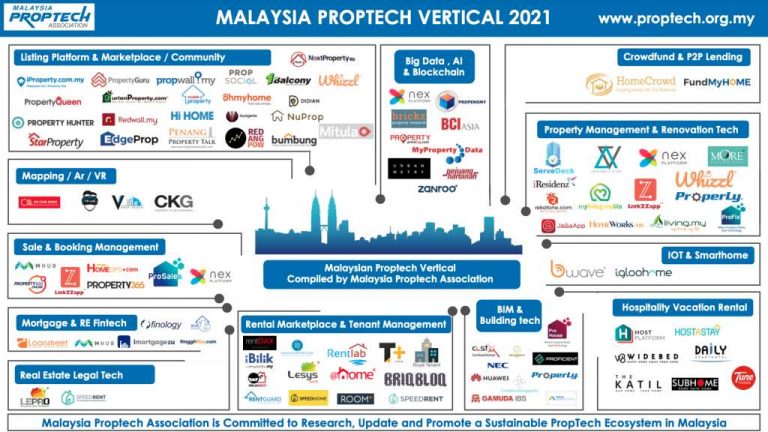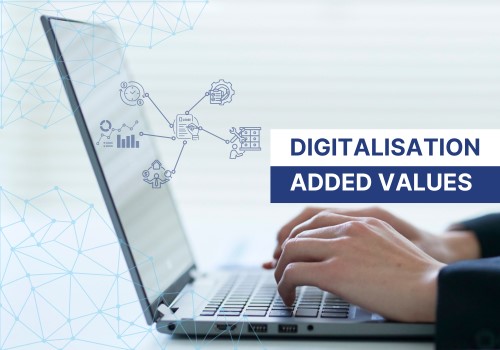From 1.0 to 4.0: The Evolution of Proptech in Facility Management

We all know how good real estate and facility management is but not many have an idea of the size which this market has on a world scale. The latest report on “Real Estate Market Size 2019/2020” by MSCI, sizes it at USD 9.6 (RM38.4) trillion, best is, this value refers to the professionally managed properties only. It might not be sufficient to multiply it by three times to have the actual value of all properties worldwide!
The numbers above represent huge opportunities not only from a market size and lack of tech adoption viewpoint, but also considering how much the real estate industry has been, since ever, plagued by inefficient processes and very often useless high transactional costs strongly defended by self-interested professionals and institutions. In other words, all the professional advisors that are involved and dominate the transaction process and the facility management clearly have a huge interest in protecting their income sources.
From chartered surveyors to brokers and from lawyers to real estate agents all of them or at least the greatest part, have been resisting tech-driven innovations designed to ‘intentionally disrupt’ their work with the aim of making the industry more efficient and transparent!
PROPTECH 1.0
Another less known fact is that technology applied to property, nowadays known as PropTech, started long ago, in the middle 80s to be precise.
At that time, with computing becoming more and more popular together with its “fast calculating power”, the big real estate players in US, UK and Europe started using it to record transactions, values, historical values and more.

However, as we all somehow know, real estate, comprising planning, construction, transaction and, facility management, has a strong brick-and-mortar mindset. Change and adoption of new technologies, have often been slowed down or even rejected by most of the “institutional” market players making a further advancement, studies and tech application very hard and lengthy!
However, technology adoption, it doesn’t matter referred to which industry, is not something that can be stopped, only slowed down, eventually. Notwithstanding all the barricading against it, technology adoption by the real estate industry, kept moving forward during the years between middle 80s and 2000. Construction and project planning/design were also enjoying the innovative wave with AutoCAD and BIM (Building Information Modelling) software being developed in UK and US and start being largely used by market players.

It was only towards the end of the millennium, 1999-2000 that finally more technology innovation started making its way through towards the public and the second wave of Proptech 2.0 begun building momentum.
PROPTECH 2.0
Leveraging on more advanced and affordable computing technology, during the first years of the new millennium several real estate players launched the first B2C wave of Proptech products, the now well-known online property portals.
Between 2000 and 2005 the UK and US real estate residential markets saw a mushrooming trend of online portals from Rightmove (UK in 2000) to Trulia (US 2005) plenty of new players showed off with user-friendly and web-based property portals boosting the market penetration towards the consumers.
During those years, these innovative technologies, leveraging on the fast growing and affordable personal computer adoption, brought to the public online tools used to search properties and make useful comparison from the comfortability of the house or office. Facility Management also got started attracting attention of various software houses and some of the very first solutions helping building managers to keep record of their daily work and organise their scheduled maintenance.
The growing demand for this type of innovative services, combined with a fast-moving technology market fired up and boosted the market value of the first players and started attracting deep-pocket investors attention. In 2015, just to mention one example, in US Trulia was acquired by Zillow for the whopping amount of USD2.5 billion. The fuse was on and everywhere around the world, from East to West and South to North Proptech 2.0 started a more disruptive and unstoppable innovative wave.
In South East Asia the first players appeared between 2005 and 2007 with iProperty being launched in Malaysia while PropertyGuru appeared in Singapore. These online tools, besides helping consumers finding the right product, attracted plenty of developers and agents showing off their carnets and started generating huge business turnover.
Starting from 2009, iProperty and PropertyGuru expanded their wave towards almost all countries in South East Asia while more innovative and “pain point” solving technologies appeared in more developed markets such as US, UK, Europe and Australia/New Zealand. The first Proptech horizontals and verticals from these countries, showed how deep and substantial was the impact of innovation and technology on the real estate industry including the facility management segment.
Interesting to compare two tables showing the before and after Proptech 2.0 to understand the high potential and future business opportunities generated by the disruptive movement of all these new start-ups.
Looking at the three areas impacted by Proptech during the 90s the horizontals/verticals table below is just highlighting the potential and/or availability of tech-solutions with a simple “yes”.

In comparison, the table besides which was elaborated by James Dearsley, co-founder of Unissu in UK, in 2014, gives a good idea of the market size and unveils the huge opportunities for both disruption and highly profitable investment-funding. UK has been a precursor of the huge disrupting wave that was getting ready to change the way we looked at real estate, transactions and facility management.

Still, most of the available tech-solutions where limited to information, transaction and commercial facility management areas of interest. While real estate main pain points were resolved by the impact of innovative technology, another crucial and disrupting wave was mounting.
Mobile devices, smart-phones and, tablets progressively became more affordable and widely used while Wi-Fi and 4G offered easily accessible internet services from anywhere. These were, between 2008 and 2014, the key factors preparing the ground for the third big hit of Proptech.
During those same years, another important trend, happening everywhere in the world, played an important role in further pushing towards implementation and full adoption of new technologies. It was the rapidly growing urbanisation trend combined with a refreshed direction of “Smart-city” development.
Commercial building, as first, saw an increased number of possible facility management solutions appearing in the market with ServeDeck being one of them, The smart-city paradigm added the word smart in front of all its six pillars: people, governance, environment, mobility, economy and living.
This “smart” change opened the door to a brand-new and strong push towards a deeper and more effective impact of technology throughout all the different layers and players in the real estate industry, from planning to construction and facility management and, prepared the ground for the third disruptive hit of the Proptech wave.
Before looking into what has happened to the real estate industry, it is good to understand how Fintech, that many have used and leveraged on for real estate applications, and Proptech have been overlapping and cooperating to build each other strength.

This image, sourced from an interesting paper on Proptech prepared by the Said Business School, part of Oxford University, in 2017, shows the actual positioning of the different forces which have made the Proptech growth faster and stronger. Fintech, which comes into play once the actual transaction happens, has helped new Proptech start-ups gaining the needed trust by industry players and institutional entities to become recognized first and widely used later.
Nowadays most Proptech solutions are incorporating established and approved payment gateways and e-commerce payment solutions all developed by the “elder” Fintech sister.
PROPTECH 3.0
The first kick towards Proptech 3.0 was generated by the introduction of deeper and more AI driven big data analysis, machine learning and blockchain. Real estate players, were mostly happy with the outcome of the introduced automation for lead generation and management (real estate agents and property developers), facility management (assets managers), market trends and analytics (real estate marketers), rental and leasing solutions and much more.
Fully integrated multi pain point solutions start appearing, and Malaysia too saw plenty of newly established Proptech start-ups offering viable solutions to all of the above.
Following the from-zero-to-hero way, MPA (Malaysia Proptech Association) established in 2017 by few major players as members, grew fast to more than 50 in the following couple of year and is today looked at as one of the major regional players.
Today, within the multiple verticals of MPA, it is possible to check the location of a project online, visit virtual sales gallery and related show units, discuss with the sales representative, book, check mortgage eligibility, receive the keys of a new property and check the possible defects and more all online.
Solutions are also available under the property management verticals with all-in-one facility management digital solutions and in the ConTech vertical with several fast growing start-ups.

Real estate players are now appreciating the Proptech offering of solutions for rental, id decoration, facility management, big data analysis, valuation and much more and new start-ups keep on bringing to the market new and innovative ideas. Best is to keep an eye on the MPA website here to be updated on the latest news on new Proptech solutions.
Within the several success stories of MPA, a very good example of integrated and in-house developed tech solution for real estate players is ServeDeck. A fully self-funded start-up offering a fully integrated digital solution for facility management, CMMS, operation management and more, was released in 2018 gaining immediate attention in market.
When, in March 2020, Covid-19 stroke and the pandemic became a world health issue bringing in MCO, Great Lockdown and social distancing, ServeDeck added to the main deck few features to allow full online management and control over flow of crowd and health checking. ServeDeck have since kept growing its market share in Malaysia and beyond bringing a smart digitalized all-in-one solution for facility management to various countries in the region.
Facility managers, after experiencing the difficulty of operating and managing their facilities with less or none staff on site have found a perfect digital smart solution to their challenges in ServeDeck which offered them a fully integrated solution.
PROPTECH 4.0
What comes next? Since the beginning of the Covid-19 pandemic, the great Lockdown and all the restrictions imposed by the new normal social distancing, technology, not only for real estate, has been moving forward with giant steps. AI is nowadays normally used to collect, analyze and elaborate data while 3D and 4D are bringing fresh air in the virtual visiting and showing of real estate products.
Various members of MPA are pushing on the accelerator and promising tech fireworks for 2022 and ServeDeck has been placing itself at the frontline of this new and stronger Proptech wave.
Keep on following us as few more articles will walk the readers through the tech park of the future to allow a “get-fit-and-ready” for all while looking forward to this strong Proptech dawn.
ABOUT THE AUTHOR

The opinions expressed in this article are solely of the author, Dr Daniele Gambero.
Dr Gambero has been an expatriate to Malaysia from Italy, since 1998 and has more than 35 years of real estate experience. He is the co-founder and group CEO of REI Group of Companies, the Co-founder of Propenomy.com and the deputy president of the Malaysia Proptech Association.
In the past 10 years Daniele, as international and TEDX speaker, has engaged several hundreds thousand people talking about Property, Economy, Propenomy, Digital Marketing and Motivation. He is also a bestselling author and columnist on several magazines and main stream media. You can reach him directly through his LinkedIn page here.
SHARE THIS POST:
Comments (1)
Leave a Reply
Your email address will not be published. Required fields are marked *







